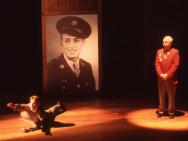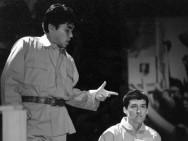The American POW Drama
It is somewhat of a daunting task to consider how in the world to make a play about a stockade where a lot of people died over time. Unlike many of the other depictions of the POW experience, there wasn’t really any interaction between prisoner and guards that could help to build the drama. At Andersonville, prisoners were just thrown into a huge stockade and left to fend for themselves.
I began casting about wildly to try and find something to inspire the writing of this play. I read Gene Genet, Theater of Cruelty, as well as some of the writings of Jean Paul Sartre on the nature of freedom. But it wasn’t until I decided to attend a meeting of the Georgia chapter of the American Prisoners of War Society that I began to understand how to approach this effort.
I am not sure why I decided to go to this meeting. At the time, I didn’t see what the experience of prisoners from Korea or World War Two was going to tell me about the Civil War. But talking with the men from many different conflicts about their experiences I realized that there were universals in the POW experience that cut across all wars and circumstances. Some of the things that held true for prisoners in the 20th century also held true for the POWs at Andersonville. Suddenly, I had a window into the people I could never meet.
I found that a large function of the meeting was to help them heal each other through the discussion of their common traumatic experience. In addition, and witnessing their interactions with each other, I was still struck by the way the men discussed their experience among themselves as a way to heal from their traumatic experiences. Also, by viewing a cross-section of POWs from World War Two on through to the Vietnam War, it was possible to see the different stages of this healing process. The extent of the counseling most of these men received upon arriving home was that they were simply told to forget about what happened to them. Most actually took this advice, only to later be imprisoned by the residual effects that wouldn’t let them forget their experiences. Many complained about an inability to sleep at night, reactions to loud noises, or sudden bursts of anger that would manifest itself in inappropriate ways. In time, they began to talk about their experiences as a POW, initially with people who had had the same sort of experience. But the way they talked about it changed over time, as well. I noticed that the Vietnam vets with whom I spoke recalled their stories with a rigidity and attention to superfluous detail, while those from earlier conflicts had more time to let the story settle and were more able to engage in a free and wide ranging conversation about their experience.
I felt as though these men were still reaching for a freedom from their captivity that they hadn’t quite achieved. It occurred to me that if they could somehow take their story and tell it on stage to a room full of strangers, this would be a progression of the process they had entered into, and that by doing so, they would be able to cut the final link in the chain between themselves and their captors.
I also began looking at the world outside the stockade during the time of the Civil War. Of course, the South was still participating in the institution of slavery and a lot of these slaves were used to build the stockade and to help keep it going. I had read, also, of people who lived outside the stockade who sensed that terrible misery that was going on there and who tried unsuccessfully to bring food to the prisoners. I assumed this came out of a shared sense of suffering these people felt over the fate of their enemies. It made me think of Jean Paul Sartre’s idea that through the act of imprisoning another, a person is also imprisoning himself.
The trick to writing this play was to bring these elements together and to reach for the universal truths of freedom and captivity inherent in the whole of it. In the end, the characters I created for the Andersonville drama raised issues of freedom and captivity that were commented upon by actual POW’s who participated in the show live each night. The bridge between the experience of these men and the experience of the Civil War characters created universality in the experience of all prisoners of war. This was supported by a character in the play who was somewhat ‘unstuck in time’, and who represented the universal POW experience. The slave narrative and the poignant spiritual songs that commented on the themes of the play throughout, offered another layer to what had become a story about freedom and captivity. Finally, the despair of the people living outside the prison over the things they are a part of, but cannot change, embraced the despair of which Sartre had spoke.
In the end of the play, the person who is most free is the slave in shackles for refusing to be a part of something he believed to be wrong, while the person who is the least free is the Antebellum Southern woman who is frustrated in her attempts to feed the prisoners.


